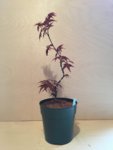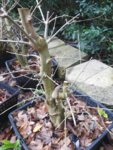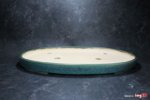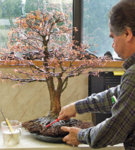Yes,
and yes.
Sorry, just poking a little fun.
Container grown only means it was not grown in the ground. It does not mean it was grown in a bonsai pot.
Should you plant a seedling or cutting in a shallow, wide bonsai pot? The answer is no, or rather this is the slowest route to a mature bonsai possible. 40 years minimum even in skilled hands.
Trees need to grow in order to have branches to choose from to do styling. If you confine the roots to a bonsai pot, the growth will slow, and in particular the trunk of the tree will slow or just about stop increasing in diameter. I kept a pomegranate its entire life in a bonsai pot. It started as a little cutting, maybe 1/16th inch diameter stem, at 35 years, when I got rid of it, it had a trunk barely 1 inch in diameter. To look good in the style it was in, it needed to have a 2 or 3 inch diameter trunk. Keeping a seedling in a bonsai pot will definitely slow the development of trunk caliper. Note, if I lived in a climate where I could have put the pomegranate in the ground, I could have had a 6 inch diameter trunk in less than 10 years. In the right climate, they grow fast.
However, container growing, while not as quick as ground growing, can very effectively size up trees for medium to smaller sizes of bonsai. Growing in containers makes it easier to set the tree on a work bench and do needed pruning and other adjustments as being developed. I weight near 300 pounds, there is no way I am flopping down on my belly to prune or wire trees growing in the ground. I'd never be able to get up. So container growing can and is done regularly, by many growers.
If you use containers that hold the equivalent of 3 to 5 gallon nursery cans of potting media, you can usually get enough growth that in less than 10 years, often less than 5 years you can get trunks in the 2 inch to 4 inch diameter range from a fair number of species. (note individual results depend on climate, and species). My favorite growing out container is a 16 x16 x 5 inch deep Anderson flat. It holds roughly the equivalent of 3 gallons of potting media. I rarely fill these Anderson flats to the 5 inch depth, I usually use them at about 3 to 4 inches deep, a little less media, and produces a shallower root system. I use them for individual trees, or when I am starting a batch of seedlings. 100 seedlings will need to be thinned to 25 the second year, so on.
Now it is important when starting with young stock, to not drastically over pot. You will need to step a seedling up into larger containers until you get to the largest container you want to use in your set up. It really doesn't matter if these pots are nursery pots or are fine bonsai containers, as long as they allow the roots room to grow. If you are careful to give roots room to spread, you can keep a young tree growing in bonsai pots the whole way. BUT if you let the tree get root bound, or if you prune too much off the root ball when you repot, you will slow the growth of your seedling. If you only prune downward growing roots, indeed this will mimic the Ebihara method. But you must make sure the tree has room to grow, or the trunk will not increase in diameter.
Note, my trees in 3 and 5 gallon nursery pots, and in Anderson flats, many are over 4 feet tall. Some have an individual branch over 6 feet long. My Amur maple, which I intend to eventually be shohin, less than 8 inches tall has spent much of the last 4 years with branches over 5 feet long in the effort to increase the diameter of the trunk. Bonsai trees at some point start out small, as a seedling or cutting or other propagated plant, then they grow, often are allowed to get quite large, then they are cut back and brought back down in size. Most bonsai that have made the 20 year old mark have spent near half their life at a size that is 5 to 20 times taller than they are when they are finally ready for exhibition. Grow up & out, then bring back down to size.
A few trees do continue to thicken up even in bonsai pots, even when the roots are kept fairly confined. These are the "exception" rather than the rule. The majority will be like my pomegranate, 35 years to get up to 1 inch in diameter. One that thickens up well in a pot is the azalea, Satsuki azalea will develop fairly well in bonsai pots.













